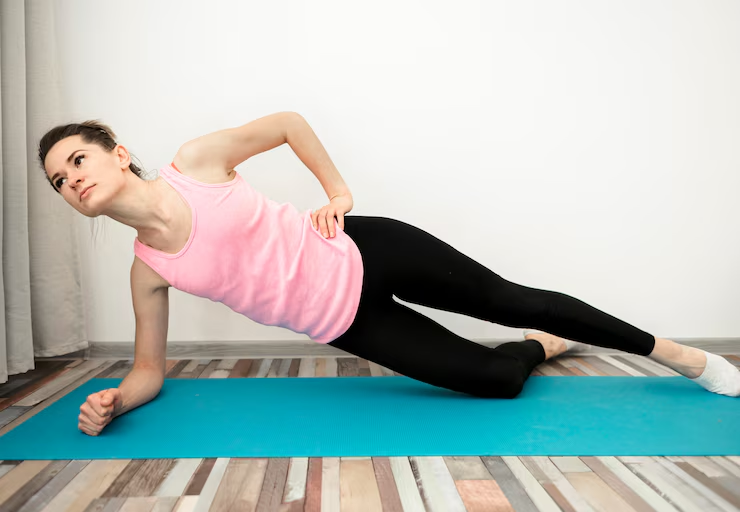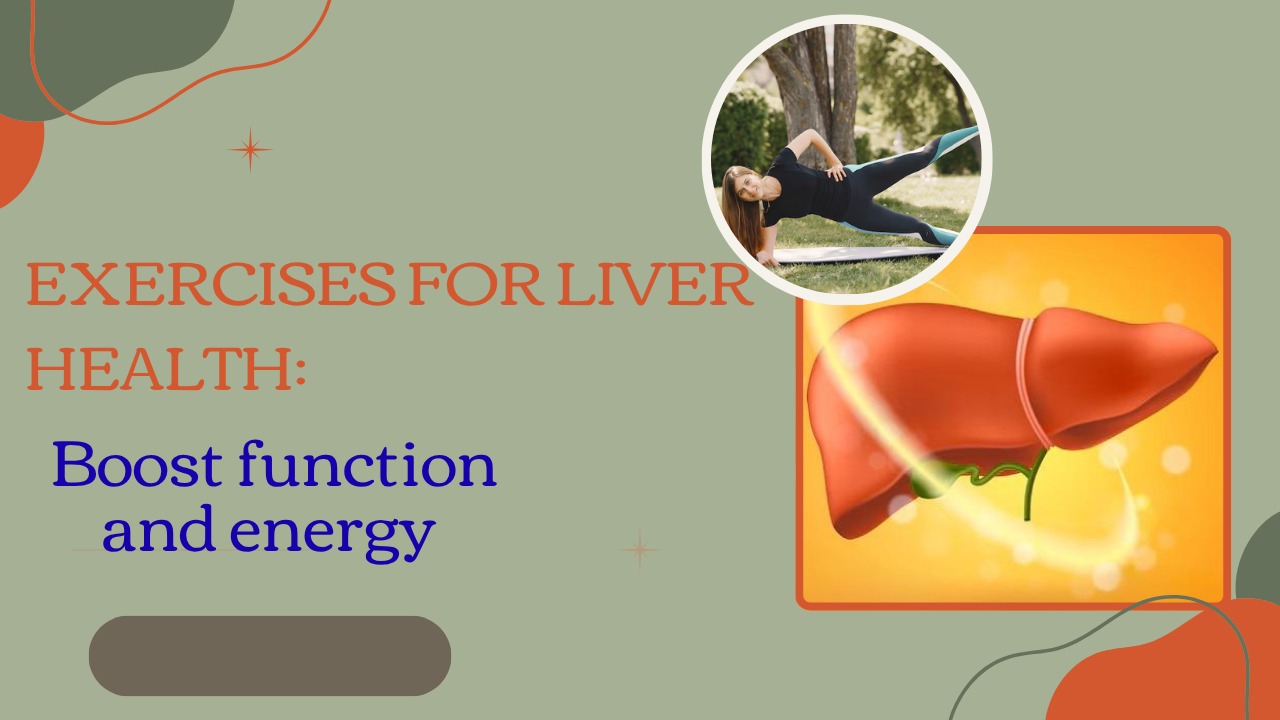The liver plays a critical role in keeping the body healthy by performing essential tasks such as detoxifying the blood, producing bile for digestion, and storing energy. As the body’s natural filter, it’s constantly working to break down toxins and regulate chemical levels. Because of its importance, protecting liver health is key to long-term wellness.
While a balanced diet is fundamental, incorporating regular physical activity is equally important. Engaging in exercises for liver health—such as brisk walking, swimming, or cycling—can reduce fat buildup in the liver, improve circulation, and decrease inflammation. These activities help prevent conditions like fatty liver disease and support overall metabolic function.
In addition to cardio, strength training exercises can also enhance liver function by improving insulin sensitivity and promoting muscle mass. A consistent fitness routine not only aids in weight management but also reduces the risk of liver-related complications, making exercise a powerful ally in maintaining liver health.
In this article, we will explore the top 8 exercises that promote liver health, how they work, and additional lifestyle tips to support your liver. Whether you’re aiming to prevent liver diseases like fatty liver, hepatitis, or cirrhosis—or simply want to optimize your well-being—these exercises can help rejuvenate and protect your liver naturally.

Why Is Exercise Important for Liver Health ?
Reduces Fat Accumulation in the Liver
One of the leading liver conditions today is Non-Alcoholic Fatty Liver Disease (NAFLD).
Engaging in regular exercises for liver health—such as aerobic workouts and strength training—helps burn excess calories and reduce visceral fat, especially around and inside the liver.
This fat reduction plays a crucial role in preventing or reversing fatty liver disease.
Improves Insulin Sensitivity
Insulin resistance is a major contributor to metabolic syndrome, a known risk factor for liver disease.
Physical activities like walking, cycling, and resistance training enhance insulin sensitivity, enabling better blood sugar control and reducing the strain on the liver.
Enhances Blood Circulation
Regular exercises for liver health improve cardiovascular function and blood flow.
Enhanced circulation helps the liver efficiently filter toxins and deliver nutrients throughout the body.
Decreases Chronic Inflammation
Persistent inflammation is a key factor in liver damage and the progression to fibrosis or cirrhosis.
Exercise acts as a natural anti-inflammatory by lowering levels of inflammatory markers and boosting immune response, protecting liver tissues over time.
The top exercises that can boost your liver health
Brisk Walking (30-45 Minutes Daily)
Brisk walking is one of the most accessible and effective exercises for liver health. It requires no equipment and can be done almost anywhere, making it an ideal choice for people of all fitness levels. Walking at a moderate pace for 30 to 45 minutes a day helps activate the body’s metabolism and burns excess calories, which is key to reducing fat around the liver.
One of the primary benefits of brisk walking is its ability to lower visceral fat, including fat stored in the liver. This is especially important for individuals dealing with or at risk of Non-Alcoholic Fatty Liver Disease (NAFLD). Consistent walking also improves cardiovascular health and blood circulation, which supports overall liver function.
In addition, brisk walking enhances insulin sensitivity and reduces chronic inflammation, two major factors that influence liver health. As a low-impact option among exercises for liver health, it can be safely integrated into most daily routines.
Why It Helps: Walking is a low-impact cardiovascular exercise that is accessible, safe, and effective. It gets your heart pumping, boosts metabolism, and helps burn liver fat.
How to Do It Right
Walk at a pace that slightly elevates your heart rate.
Aim for 10,000 steps per day, or at least 30 minutes of continuous walking.
Choose scenic or peaceful routes to reduce stress while you walk.
Pro Tip: Use a fitness tracker to monitor your step count and keep yourself motivated.
Jogging or Light Running
Brisk walking is one of the most accessible and effective exercises for liver health. It requires no equipment and can be done almost anywhere, making it an ideal choice for people of all fitness levels. Walking at a moderate pace for 30 to 45 minutes a day helps activate the body’s metabolism and burns excess calories, which is key to reducing fat around the liver.

One of the primary benefits of brisk walking is its ability to lower visceral fat, including fat stored in the liver. This is especially important for individuals dealing with or at risk of Non-Alcoholic Fatty Liver Disease (NAFLD). Consistent walking also improves cardiovascular health and blood circulation, which supports overall liver function.
In addition, brisk walking enhances insulin sensitivity and reduces chronic inflammation, two major factors that influence liver health. As a low-impact option among exercises for liver health, it can be safely integrated into most daily routines.
Why It Helps: Running stimulates blood circulation and significantly reduces liver fat. A study published in Hepatology found that aerobic exercise like running can reduce liver enzymes and improve liver stiffness.
How to Do It Right
Start with 10–15 minutes and build up to 30–45 minutes, 3–4 times a week.
Warm up and cool down properly to avoid injuries.
Keep a steady pace that allows you to maintain a conversation while running.
Pro Tip: Running on grass or a treadmill can reduce the impact on your joints.
Strength Training (2–3 Times a Week)
Strength training, performed 2–3 times a week, is a powerful addition to the list of effective exercises for liver health. Unlike cardio, strength training focuses on building lean muscle mass, which plays a key role in improving metabolism and reducing fat accumulation—both crucial for liver health. Using weights, resistance bands, or bodyweight exercises can all contribute to these benefits.
Regular strength training improves insulin sensitivity, which helps regulate blood sugar levels and reduces the risk of metabolic disorders that burden the liver. By increasing muscle mass, the body becomes more efficient at utilizing glucose, easing pressure on the liver’s filtering system. This makes strength training particularly helpful for individuals with or at risk of fatty liver disease.
Additionally, strength training contributes to lower levels of chronic inflammation, a known trigger for liver damage and fibrosis. As one of the most impactful exercises for liver health, it supports long-term liver function and overall wellness.
Why It Helps: Resistance training improves insulin sensitivity and promotes fat loss, especially in the abdomen and liver. It also builds muscle, which increases metabolism and supports liver detoxification.
Best Exercises
Squats
Lunges
Deadlifts
Push-ups
Resistance band workouts
How to Do It Right
Start with bodyweight exercises and progress to weights.
Focus on compound movements that work multiple muscle groups.
Rest at least 48 hours between strength workouts for the same muscle group.
Pro Tip: Combine strength training with cardio for even better liver benefits.
Yoga (3–5 Sessions Weekly)
Yoga, practiced 3–5 times a week, offers a gentle yet powerful way to support liver function. As one of the most holistic exercises for liver health, yoga combines movement, breath control, and mindfulness to reduce stress and promote internal healing. Specific poses like the Cobra, Seated Twist, and Bridge are especially beneficial for stimulating liver function and enhancing detoxification.
In addition to physical benefits, yoga plays a significant role in lowering cortisol levels and reducing inflammation—both of which are known contributors to liver damage. By calming the nervous system, yoga supports hormonal balance and enhances the body’s natural healing capacity, which is vital for liver repair and regeneration.
Practicing yoga also improves digestion and circulation, allowing the liver to filter toxins more effectively. Whether you’re a beginner or experienced, integrating yoga into your routine is a sustainable and restorative form of exercises for liver health that benefits both the body and mind.
Why It Helps: Yoga helps detoxify the liver through gentle twists and stretches, reduces stress (a factor in liver disease), and improves digestion and blood flow.
Best Poses for Liver Health
Ardha Matsyendrasana (Half Lord of the Fishes Pose)
Bhujangasana (Cobra Pose)
Dhanurasana (Bow Pose)
Kapalbhati Pranayama (Breathwork for detox)
How to Do It Right
Practice in the morning for the best detox results.
Stay in each pose for at least 30–60 seconds.
Focus on deep breathing and relaxation.
Pro Tip: Include pranayama (breathwork) and meditation to lower cortisol levels and reduce liver stress.
High-Intensity Interval Training (HIIT)
High-Intensity Interval Training (HIIT) is a time-efficient and highly effective workout style that alternates between short bursts of intense activity and periods of rest or low-intensity movement. As one of the most impactful exercises for liver health, HIIT helps burn a significant amount of calories in a short time, promoting fat loss—including fat stored in the liver.

This type of training improves insulin sensitivity and cardiovascular fitness, both of which are essential for maintaining optimal liver function. By reducing visceral fat and regulating blood sugar levels, HIIT minimizes the risk of developing Non-Alcoholic Fatty Liver Disease (NAFLD) and supports liver detoxification processes.
Additionally, HIIT reduces chronic inflammation and oxidative stress, two factors commonly linked to liver damage. With just 20–30 minutes of HIIT performed 2–3 times per week, individuals can experience improved metabolic health. Among all exercises for liver health, HIIT stands out for its ability to deliver rapid and long-lasting results.
Why It Helps: HIIT involves alternating short bursts of intense activity with rest or low-intensity periods. It’s extremely effective in reducing liver fat and improving liver enzyme levels.
Sample HIIT Routine
30 seconds sprint
60 seconds walking
Repeat for 20 minutes
How to Do It Right
Warm up thoroughly before starting.
Keep sessions to 20–30 minutes, 2–3 times per week.
Monitor your heart rate and don’t overtrain.
Pro Tip: Combine HIIT with clean eating and hydration for enhanced liver detoxification.
Swimming
Swimming is a full-body workout that is both low-impact and highly effective, making it an excellent choice among exercises for liver health. It engages multiple muscle groups while being gentle on the joints, making it suitable for people of all ages and fitness levels. Swimming helps burn calories efficiently, which supports weight management and reduces liver fat.
Regular swimming sessions improve cardiovascular endurance and blood circulation, allowing the liver to receive a steady flow of oxygen-rich blood. This enhanced circulation aids in better detoxification and nutrient transport, both essential for optimal liver function. Additionally, swimming helps regulate cholesterol and blood sugar levels, reducing the risk of liver-related disorders.
Another key benefit of swimming is its ability to lower stress and inflammation—two major contributors to liver damage. The rhythmic movement and controlled breathing associated with swimming promote relaxation and hormonal balance. As such, swimming stands out as a balanced and restorative exercise for liver health.
Why It Helps: Swimming is a full-body, low-impact workout that supports cardiovascular health and reduces body fat without stressing the joints, which is ideal for overweight individuals dealing with fatty liver.
How to Do It Right
Swim laps for 30–60 minutes, 2–4 times a week.
Mix strokes (freestyle, breaststroke, backstroke) for balanced muscle work.
Focus on breathing rhythm and endurance.
Pro Tip: Swimming also has a calming effect, which helps reduce stress hormones that can damage liver cells.
Cycling (Indoor or Outdoor)
Cycling, whether done indoors on a stationary bike or outdoors on the road, is an excellent cardiovascular activity that supports overall wellness and is highly recommended among exercises for liver health. It helps burn calories efficiently, promoting fat loss—especially important for reducing liver fat and preventing conditions like Non-Alcoholic Fatty Liver Disease (NAFLD).

Regular cycling enhances insulin sensitivity, which allows the body to better regulate blood sugar and reduces the workload on the liver. Improved glucose metabolism is crucial in lowering the risk of metabolic syndrome, a common precursor to liver problems. Cycling also strengthens the heart and improves circulation, ensuring that the liver receives sufficient oxygen and nutrients for proper function.
In addition, cycling can help reduce stress and inflammation, both of which negatively impact liver health. Whether done as a moderate or high-intensity workout, cycling is a sustainable and enjoyable option among exercises for liver health, suitable for daily or alternate-day routines.
Why It Helps: Cycling improves heart rate and metabolism, supports fat burning, and strengthens the lower body. It’s great for people with joint issues and helps combat sedentary lifestyle-induced liver strain.
How to Do It Right
Ride for 30–60 minutes, 3–5 times per week.
Use a stationary bike at home or explore safe outdoor routes.
Maintain a steady pace with occasional sprints for fat burning.
Pro Tip: Interval cycling can double as cardio and strength training.
Pilates
Pilates is a low-impact exercise method that focuses on core strength, flexibility, and controlled movement. It is an ideal option among exercises for liver health, especially for those seeking a gentle yet effective workout. Pilates enhances muscular balance and posture while promoting mindful breathing, which helps reduce stress—a key factor in protecting liver function.
One of the major benefits of Pilates is its ability to improve circulation and lymphatic flow, which supports the liver’s natural detoxification processes. As the liver filters toxins from the blood, improved blood flow ensures it operates more efficiently. Pilates movements also aid digestion and abdominal health, further reducing the burden on the liver.
Practicing Pilates regularly can help lower inflammation, manage weight, and improve insulin sensitivity—all of which contribute to better liver health. Whether you’re a beginner or advanced practitioner, incorporating Pilates into your routine offers a restorative and supportive approach to exercises for liver health.
Why It Helps: Pilates strengthens the core, improves posture, and enhances blood flow. It’s particularly beneficial for people who prefer low-intensity workouts but still want the liver health benefits.
How to Do It Right
Attend guided classes or follow online routines.
Focus on controlled movements and breathwork.
Practice 3–4 times a week for best results.
Pro Tip: Combine Pilates with light cardio to maximize liver support.
Additional Lifestyle Tips for Liver Health
Stay Hydrated
Water plays a crucial role in liver detoxification.
Aim to drink 2–3 liters of water daily to help the liver flush out toxins and waste effectively.
Hydration also supports digestion and enhances the benefits of exercises for liver health by aiding in cellular recovery and toxin elimination.
Eat Liver-Friendly Foods
Incorporate nutrient-rich foods such as:
Leafy greens (spinach, kale)
Turmeric (curcumin reduces inflammation)
Garlic (supports enzyme activation)
Beets (rich in antioxidants)
Lemon water (stimulates bile production)
Avocados (high in healthy fats and glutathione)
Avoid:
Processed foods
Sugary drinks
Alcohol
Excessive red meat
Avoid Environmental Toxins
Limit exposure to harmful chemicals like:
Pesticides
Harsh cleaning agents
Unnecessary medications
Use natural or organic alternatives when possible to reduce liver stress.
Maintain a Healthy Weight
Excess abdominal fat increases the risk of Non-Alcoholic Fatty Liver Disease (NAFLD).
Combine a balanced diet with regular exercises for liver health, such as walking, cycling, and strength training, to manage weight effectively.
Get Regular Medical Check-Ups
Monitor your liver function through routine blood tests.
Especially important for individuals with a family history of liver disease or those exposed to risk factors.
Early detection ensures timely intervention and supports long-term liver wellness.
Conclusion
The liver is a powerhouse organ that supports over 500 essential functions, including detoxification, metabolism, and nutrient processing. Often working behind the scenes, it’s vital to protect this silent hero of our body. One of the most effective ways to do so is by incorporating regular exercises for liver health, such as brisk walking, yoga, swimming, and strength training.

Consistency in physical activity helps reduce fat accumulation in the liver, improves insulin sensitivity, and lowers inflammation—all crucial for preventing conditions like Non-Alcoholic Fatty Liver Disease (NAFLD). Unlike high-intensity workouts, these exercises for liver health are sustainable and suitable for individuals of all fitness levels. Combined with proper hydration, a nutrient-rich diet, and stress management, they create a supportive environment for liver wellness.
The key is to start small and stay consistent. Making these healthy habits part of your lifestyle benefits not just your liver, but your entire well-being—today and for years to come.
FAQs
Q1. What are the best exercises for liver health ?
The best exercises for liver health are those that combine cardiovascular activity with strength and flexibility. Brisk walking, swimming, cycling, yoga, strength training, and High-Intensity Interval Training (HIIT) are all excellent options. These exercises help reduce liver fat, improve insulin sensitivity, and lower inflammation—key factors in preventing and managing liver diseases like Non-Alcoholic Fatty Liver Disease (NAFLD).
Q2. How often should I perform exercises for liver health ?
For optimal liver health, aim for at least 150 minutes of moderate-intensity activity per week, such as brisk walking or cycling, combined with 2–3 strength training sessions. Additionally, incorporating yoga or Pilates 3–5 times a week can improve circulation and reduce stress. Regularity is more important than intensity—consistent exercises for liver health are the key to long-term benefits.
Q3. Can exercise reverse fatty liver disease ?
Yes, in many cases, regular exercises for liver health can help reverse early-stage Non-Alcoholic Fatty Liver Disease (NAFLD). By promoting fat loss, especially around the abdomen, and improving metabolic function, exercise reduces liver fat and inflammation. When combined with a balanced diet and weight management, exercise can significantly improve liver enzyme levels and overall liver function.
Q4. Are there specific exercises to avoid for liver health ?
Generally, most physical activities are beneficial. However, people with advanced liver conditions or complications like cirrhosis should avoid high-impact or strenuous exercises without medical approval. It’s best to consult with a healthcare provider before starting any new exercises for liver health, especially if you’re managing chronic liver issues or have related medical conditions.
Q5. How long does it take to see results from exercises for liver health ?
Visible improvements in liver health can be seen in as little as 8 to 12 weeks with consistent exercise and healthy lifestyle changes. Liver enzyme levels, fat accumulation, and inflammation markers may begin to normalize with regular exercises for liver health, proper hydration, and a liver-friendly diet. Patience and consistency are essential to long-term success.


